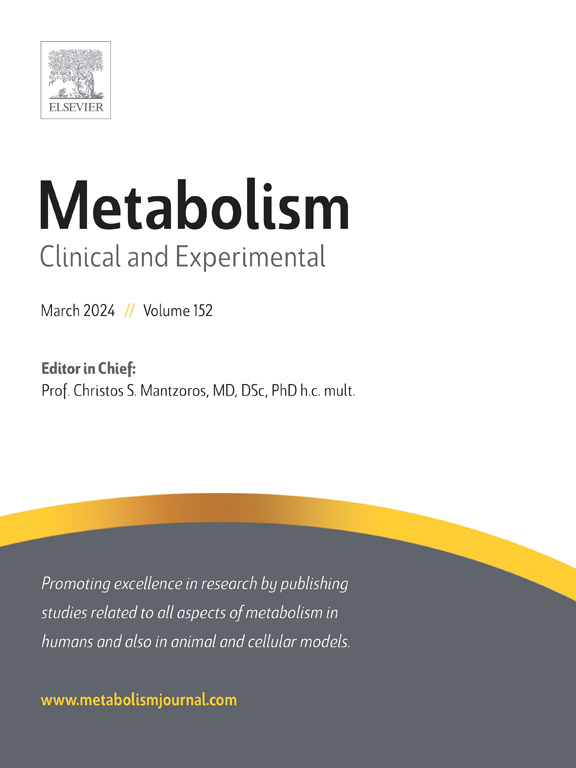AEBP1作为2型糖尿病骨骼肌胰岛素抵抗的有希望的治疗靶点:来自孟德尔随机化和功能验证的趋同证据
IF 11.9
1区 医学
Q1 ENDOCRINOLOGY & METABOLISM
引用次数: 0
摘要
背景:2型糖尿病(T2DM)的发病机制与骨骼肌胰岛素抵抗(IR)密切相关。目前,仍缺乏相关的治疗方法。基于汇总数据的孟德尔随机化(SMR)是识别骨骼肌中可药物靶点以开发T2DM治疗的重要工具。方法:通过SMR分析,找出与2型糖尿病相关的骨骼肌和血液中潜在的致病遗传因素。贝叶斯共定位用于验证因果关系。使用全现象MR (Phe-MR)评估药物靶点的多效性影响。然后,在小鼠成肌细胞系(C2C12)和人骨骼肌细胞(HSkMC)中靶向过表达或敲低AEBP1进一步验证了功能表型。通过蛋白对接、协同ip和SPR来验证蛋白-蛋白相互作用。结果:欧洲和亚洲人群显示,AEBP1与T2DM及其血液和骨骼肌血糖谱显著相关,并被确定为一个危险因素。共定位分析表明,AEBP1和T2DM起源于相同的遗传变异。同时,AEBP1靶向治疗无潜在不良反应。此外,AEBP1在体内和体外IR模型中均有显著表达,与SMR结果一致。AEBP1的过度表达进一步损害了胰岛素信号传导和葡萄糖转运机制,加剧了骨骼肌IR。靶向AEBP1敲除逆转了这些变化。蛋白相互作用实验表明,PI3K (p110β)是AEBP1发挥分子功能的直接靶蛋白。结论:靶向AEBP1治疗有望成为预防和治疗T2DM的关键途径。本文章由计算机程序翻译,如有差异,请以英文原文为准。

AEBP1 as a promising therapeutic target for skeletal muscle insulin resistance in type 2 diabetes mellitus: Convergent evidence from Mendelian randomization and functional validation
Background
The pathogenesis of type 2 diabetes mellitus (T2DM) is closely related to skeletal muscle insulin resistance (IR). Currently, there is still a lack of relevant treatments. Summary-data-based Mendelian randomization (SMR) is a vital tool for identifying druggable targets in skeletal muscle to develop T2DM treatments.
Methods
Potential causative genetic factors in skeletal muscle and blood causally associated with T2DM were identified by SMR analysis. Bayesian colocalisation were used to validate causality. Pleiotropic impact of drug targets was assessed using phenome-wide MR (Phe-MR). Then, targeted overexpression or knockdown of AEBP1 in mouse myoblast cell lines (C2C12) and human skeletal muscle cells (HSkMCs) further validated the functional phenotype. Protein docking, co-IP and SPR were used to demonstrate protein-protein interactions.
Results
Both European and Asian populations revealed that AEBP1 was significantly associated with T2DM and its glycemic profile in blood and skeletal muscle, and was identified as a risk factor. Co-localisation analyses suggest that AEBP1 and T2DM originate from the same genetic variants. Meanwhile, targeted AEBP1 therapy has no potential adverse effects. Furthermore, AEBP1 was significantly expressed in in vivo and in vitro IR models and was consistent with the SMR results. Overexpression of AEBP1 further impaired insulin signalling and glucose transport mechanisms, exacerbating skeletal muscle IR. Targeting AEBP1 knockdown reversed these changes. Protein interaction experiments revealed that PI3K (p110β) is a direct target protein for AEBP1 to exert molecular functions.
Conclusion
Targeting AEBP1 therapy is expected to be a pivotal approach for the prevention and treatment of T2DM.
求助全文
通过发布文献求助,成功后即可免费获取论文全文。
去求助
来源期刊

Metabolism: clinical and experimental
医学-内分泌学与代谢
CiteScore
18.90
自引率
3.10%
发文量
310
审稿时长
16 days
期刊介绍:
Metabolism upholds research excellence by disseminating high-quality original research, reviews, editorials, and commentaries covering all facets of human metabolism.
Consideration for publication in Metabolism extends to studies in humans, animal, and cellular models, with a particular emphasis on work demonstrating strong translational potential.
The journal addresses a range of topics, including:
- Energy Expenditure and Obesity
- Metabolic Syndrome, Prediabetes, and Diabetes
- Nutrition, Exercise, and the Environment
- Genetics and Genomics, Proteomics, and Metabolomics
- Carbohydrate, Lipid, and Protein Metabolism
- Endocrinology and Hypertension
- Mineral and Bone Metabolism
- Cardiovascular Diseases and Malignancies
- Inflammation in metabolism and immunometabolism
 求助内容:
求助内容: 应助结果提醒方式:
应助结果提醒方式:


